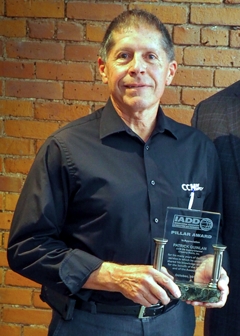Patrick Quinlan
2017 Pillar Award Recipient
 PQ-Pedia
PQ-Pedia
Patrick Quinlan Receives
2017 IADD Pillar Award
What do you do when someone consistently provides so much phenomenal technical advice and information that he becomes known as your industry’s go-to encyclopedia? Give him an award, of course!
That’s just what IADD President Shaun Larson of Jonco Die Co. Inc. did at the recent Can-Am Chapter meeting in Buffalo, NY, USA. Recognizing Patrick Quinlan of Channel Creasing Matrix, Inc./CCM Die Supply, Larson noted, “About six months ago, I got a call from my father-in-law, John Gordon. He told me that the IADD should have an award for people who have always been faithful to the vision of the Association being the definitive industry resource. He suggested we recognize people who have consistently been willing to present programs, provide information in articles and serve on TechTeam. He specifically mentioned Patrick as a potential recipient. What he didn’t know is that, coincidentally, the Board had just created the IADD Pillar Award for that very reason, and using that very person as an example of someone who fit the criteria.”
In fact, when the award process was announced, Quinlan was nominated by two different people: Abbey Stoddard and John Gordon. Abbey Stoddard of Channel Creasing/CCM Die Supply said, “Pat is most deserving, having served on the IADD TechTeam, written numerous articles for The Cutting Edge and done countless educational presentations at IADD chapter meetings all over North America.” Abbey continued that “he has the patience of a saint, the knowledge of someone with a PhD and the ability to explain things in a way that nearly everyone can understand. Pat understands our industry and all it entails so innately; when he shares his information, it seems effortless—like whatever you’re asking about he just encountered yesterday. So of course he knows how to handle it. He is a repeat speaker at IADD Chapter meetings and writes articles for The Cutting Edge because he has such a wide breadth of knowledge—50+ years working all over the country at a myriad of converting facilities means there isn’t much he hasn’t seen or dealt with.”
According to John Gordon of Jonco, “Pat has always been faithful to the Association. When he says he’s going to do something, he does it. He is one of the best speakers the IADD has to offer. His information is always relevant and current. And as a colleague, I can testify that he gives his all to whatever challenges may arise.”
During the presentation, Larson noted, “Pat holds the record for being the longest standing chapter officer, having done so for 30 years now. He was selected for this award during the presidency of Jeremy Guest, and when Jeremy called him to alert him of being chosen to receive it, in typical Pat Quinlan fashion the conversation went like this:
Jeremy: Hi, This is Jeremy Guest from Diansuply. Are you busy?
Pat: Yes. Well, no. I am at a customer’s, in his lobby waiting for him.
Jeremy: Well, do you have a second?
Pat: No, he’s coming. I will call you back. CLICK.
Pat is always real with you no matter who you are. I cannot think of someone more deserving of this award. He is one of the IADD’s pillars, providing tireless, overwhelmingly faithful support, and we need people like him to bring strength to our Association. He is definitely on of our pillars.”
Quinlan says he was born into the brown box corrugated industry. “My father was a shift foreman at the Robert Gair Company in North Tonawanda, NY, USA. He met my mother there, who was working in the office. My brother Pete and I used to go into the factory on Saturday mornings with my dad as he finished up some leftover jobs. We visited the factory cats and climbed into the empty railroad box cars and truck trailers which were all parked inside the huge building.”
“I think that I was 12 years old when my dad decided that our area needed a good steel rule dieshop, so he started a part-time business in our basement. In those days I made $.25 USD per hour rubbering dies. We used to have crates of Finnish birch delivered to our house from Carl Lightfoot. They were dropped off the back of the trailer right onto our driveway. My father would break the crates open and wait for me to come home from school to help him carry the boards down into the basement. Within a couple of years, corrugated steel rule diemaking became the full-time family business. In 1964, we moved to a new building with upstairs living quarters. We were then into diemaking big time, including the recently developed soft anvil rotary dies.”
Early career
Quinlan’s career path started when he was about 15. “All I did was either go to school or work in the dieshop on every type of steel rule die that we could sell: corrugated dies, gasket dies, blister dies, bolted clicker dies and dies for commercial printers.” Eventually he became the layout specialist while his brother was the jigsaw guy. They all worked in knifing and rubbering. In 1976, he started to explore the idea of making dies for the folding carton industry because there were no other markets left for expansion.
He explains, “Folding cartons, while being another form of paper packaging, are way different than corrugated. It took two years just to sell our first folding carton die. There was a lot to learn about folding cartons. Initially, we kept the corrugated tooling and the folding carton tooling as separate areas within the shop until that fateful day in the early 1980s. We were fortunate that Lawless Container in North Tonawanda was an early pioneer in litho-laminate corrugated packaging.”
“One day Lawless Container told me that they had an E-flute solid black electronics box design that simply could not fracture when folded. I suggested that we supply them with a lasercut folding carton die and a matching phenolic counterplate to make the creasing more precise. Everything worked out great with that job and soon things went back to business as usual. A while later, Lawless Container again asked us to build a set of folding carton tools for another project. Their reason for the request was that the new project was priced with very tight margins. I asked them why, with tight margins, would they want to pay extra for premium tooling? They answered that the earlier job for the black electronics box ran through their folder-gluers at high speed with very little waste. That was when the light bulb lit up and we realized that we had discovered a new market.” Soon they no longer produced corrugated dies and folding carton dies—they only made Bobst cutting dies for all types of materials that were produced, with one single standard of craftsmanship.
Industry inspiration
“Over the years I have had great co-workers who taught me a lot. At AccuDie there was my father Al and brother Pete, plus Al Hoak, Dan Witucki, Tim Chriswell, Tom Andrews, Jeff Schraudt, James Orman and Paul Gassman. At Synergy Tooling Systems, Inc., it was Rich Morrison and Frank Zynski. Now at Channel Creasing Matrix, Inc/CCM Die Supply, I work with Joe McDowell, Bob and Abbey Stoddard and Cindy Nine. You are only as good as the people you work with.”
“I have always held Kevin Carey in high regard. He was a skilled diemaker, but in addition he was a student of the diecutting process. He studied all the diemaking/diecutting functions and questioned the status quo of each. Kevin collected information and technology from all corners of the industry to share with others. Kevin changed the way I looked at everything.”
When asked why someone would want to share their knowledge in such a competitive industry as ours, Quinlan replies, “I guess that I have Farmers Insurance syndrome: I know a lot because I’ve seen a lot. I think that it is sort of unique to have worked in brown box corrugated then to have jumped into something like folding cartons that is a parallel industry but one that is so incredibly different. I also have collected technically-related information about diemaking and diecutting for about 35 years. My library began when I started to save technical articles in paper form and simply placed them into a desk drawer. Eventually, the drawer became overcrowded with drawings and technical papers.”
“I decided that I needed to set up a filing cabinet with individual topic folders. I sorted out my initial collection and continued to add to it over the years. I now have my library to assist me when I am asked technical questions. The library includes information from sources such as Kevin Carey, Randy Norman of Preco and Clint Medlock of Stafford. I find that sharing technical information is a fun and rewarding activity. I am sure that Kevin, Randy and Clint would agree.”
IADD involvement
Quinlan’s father Al strongly supported the concept of a diemaking/diecutting association and was involved with the early NADD (National Association of Diecutting and Diemaking) group right from the beginning. He says, “My mother always claimed that she was the first woman to attend an Association meeting. As part of the second generation, Pete and I did not get to participate in early Asociation activities. Our job was to remain in the shop to keep the work flowing. We were aware of what was going on,but only from reading information that was brought home. In every family business, the next generation finally gets their turn to participate. I think that I was on the NADD Board of Directors when the Association name was changed to IADD.”
Quinlan believes that belonging to the IADD “is the part of the learning process where you get to meet others who do the same work that you do. Some of the people who I met through the association were actual industry pioneers and innovators such as Ray Miller, Phil Saunders, Fred Isler, Bob Carter, Jean Benoit, Russ Smith, Bob Larson, John Pohlman and John Gordon. I made an effort to meet as many as possible and to spend time with each. Everybody actually was willing to share information. In 1975, Ray Miller gave me, at age 27, a personal tour of Atlas Die in Elkhart, IN, USA. The tour ended in his very nice office where he shared a glimpse of the future with me—a small chemically-etched cutting die.”
“The most satisfying part of my IADD experience has been my work with John Eales of Radiant Lasercut in founding the Can-Am Chapter in 1988. Our first meeting was held in Niagara Falls, ON, Canada. Our second meeting in the spring of 1989 in Toronto, ON, Canada featured Fred Isler from Bobst. We had 157 people at that meeting. It is very rewarding to see that the chapter is still very active 30 years later with a whole new generation of young members. Over the years, there have been many nationally-active IADD contributors who have come out of the Can-Am Chapter such as Charlie Kinsey from Wagner, Reg Cunningham from Everett, Gino Gualtieri from Central Die Supplies, Steve Brighton from Die-X, Ian Young from Diebec, Dave Whalley and Derrick Ames from Die Supply Guys and Gord Peters from Peters Steel Rule Dies.”
Quinlan encourages people entering the industry “to pay attention and be observant. Every work experience is a learning opportunity. One of my favorite sayings is that there are three kinds of people in the world: those who make things happen, those who watch things happen and those who wonder what happened.”
IADD congratulates Patrick Quinlan as a 2017 Pillar Award recipient. See other IADD awards and honorees online here.

